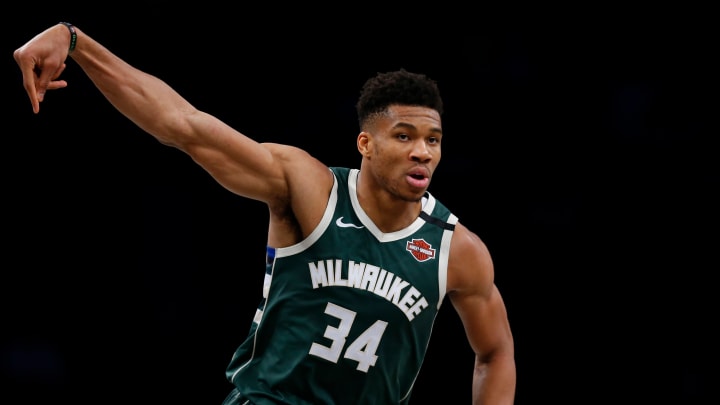So You Want to Train Like One of the World's Fittest Athletes?

Milwaukee Bucks forward and reigning NBA MVP Giannis Antetokounmpo can score in the paint and sink shots from the outside with his 7’3” wingspan. At age 24, ski racer Mikaela Shiffrin has 66 (and counting) World Cup victories. Ultrarunner Courtney Dauwalter dominates distances over 100 miles. Novak Djokovic can stretch his lean, limber body for a backhand return just as easily as he can slap a powerful serve across the net. Eliud Kipchoge can run 26.2 miles in under two hours, while Brigid Kosgei can complete a marathon faster than any woman in history.
History-making, world-class performances aren’t only a result of superior talent or skill—athletes must also be in peak physical shape. The athletes named to SI’s 2020 Fittest 50 list represent the best-of-the-best when it comes to conditioning benchmarks such as speed, strength, agility, flexibility, power, stamina and more. But how do they do it? Many of the world’s fittest athletes will do whatever they can to get that extra edge over the competition, from employing a team of trainers, nutritionists and other specialists, to utilizing science-backed methods and high-tech equipment.
While you might not be able to hire a full team to support your fitness goals, we all can learn from the advanced techniques of the world’s fittest athletes.
Bands, Bands, Bands
Olympian and world champion steeplechaser Emma Coburn uses resistance bands for warming up muscles, increasing mobility and upping the intensity of gym workouts. From mini sizes to longer lengths, resistance bands help Coburn with strength-building and stretching. The 29-year-old loops them around her ankles to help with mobility; adds them to side planks and other core exercises for an extra challenge; and use them to help activate her hip, leg and glute muscles before setting out on a long run.
Mindfulness Matters
Two-time Olympic wrestling champion Jordan Burroughs has moved forward after his disappointing finish in Rio 2016, but he hasn’t forgotten the experience as he prepares for Tokyo 2020. After the loss, Burroughs used mindfulness training to help him move past the defeat and learn from the despair. By reflecting on the past, changing his mental approach and utilizing visualization techniques in his training, Burroughs hopes to feel more prepared to bounce back and capture gold in Tokyo. And Burroughs is hardly the only athletes using mindfulness to get an edge—even powerful and punishing boxers like Deontay Wilder have incorporated meditation and visualization techniques to help himself mentally prepare for fights. Wilder prefers an app called Headspace, but there are many options available for any athlete looking to add meditation to their training arsenal.
Plants for Power and Performance
At the 2020 Australian Open, Serbia’s Novak Djokovic defeated Dominic Thiem to win his 17th Grand Slam title, adding to his already impressive résumé. The 32-year-old is known for his superior fitness, but also for his commitment to a strategic (and sometimes strict) diet. “I'm very pleased to be plant based and play at this level,” he said in a press conference after a win at the 2020 Australian Open. “There's been a lot of criticism. People around me didn't really think that I could do that. There was a lot of doubt and a lot of question marks.” Djokovic has discussed the benefits of his gluten-free diet on his performance, specifically in terms of helping him rebound from injury and extend his career. Reducing the amount of meat and dairy in your diet and adding in more vegetables, fruit, beans, nuts, seeds and healthy oils is an easy way to incorporate a pro-tip into your own life.
Quick Kicks
It’s no secret that 2019 was the year of history-making performances in the world of running. After Eliud Kipchoge broke the two-hour marathon barrier in Oct. 2019, Brigid Kosgei made history of her own just 24 hours later, breaking the women's marathon record set by Paula Radcliffe by more than a minute with a 2:14:04 finish at the Chicago Marathon—and that’s not to mention the various men’s and women’s world records for the 10K, half-marathon and more. While athletes are certainly getting fitter and faster, shoe technology is also getting more advanced, so much so that World Athletics, the global governing body of track and field, released new regulations on footwear in January 2020, banning any shoe with a maximum sole thickness of more than 40mm and shoes that contain more than one plate.
While the debate about technology in footwear will certainly be an ongoing issue in athletics, there’s a lesson we can all learn from the elites: equipment matters! Whether you’re looking to shave seconds off your mile time or aiming to hit a PR in the gym, it’s important to have footwear (and other equipment) that’s in line with your fitness goals.
